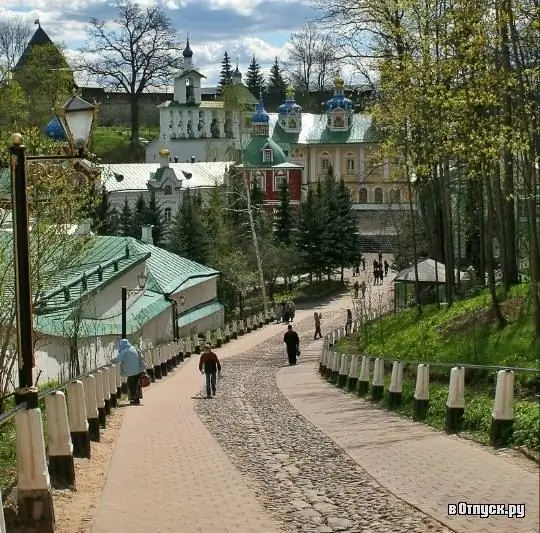
Description of the attraction
The Pskov-Pechersky Monastery is an ancient shrine of the Pskov region. Located in the city of Pechora. This is one of the largest monasteries in Russia. In addition, he is considered one of the richest.
The natural cave, from which the monastery began, existed before its foundation and was known to the local population since 1392. Since 1470, the first monk Iona settled here, who was the priest of the church of St. George of St. George of Livonian. He dug a cave for a church dedicated to the feast of the Assumption of the Blessed Virgin Mary, which was consecrated in 1473. An ancient monastery began to form around the temple. Thus, the date of foundation of the monastery coincides with the foundation of the first cave church in honor of the Dormition of the Most Holy Theotokos.
Here the Monk Martyr Cornelius asceticised. From an early age he was tonsured in this monastery and gained respect among the brethren for his asceticism and righteousness. In 1529, 28-year-old Cornelius was elected abbot. Since that time, the monastery has been actively developing and reached its heyday. The number of monks increased, the Pskov chronicle center, icon painting and pottery workshops were formed, and the casting of bells began. Abbot Cornelius paid special attention to educational and educational activities. The abbot himself in 1531 wrote "The Tale of the Pskov-Caves Monastery", after that "The Third Pskov Chronicle", "Description of the Miracles of the Pechersk Icon of the Mother of God."
At the beginning of the 16th century, under his tutelage, a book and literary school was created in the monastery, which collected liturgical manuscripts and books, the lives of saints, as well as secular works. During the Livonian War, Orthodox churches were founded in the conquered territories under his mentorship, they regularly commemorated the fallen soldiers, hegumen Cornelius himself helped the victims, supported the spirit of the soldiers in the struggle for their homeland. Also during his reign, large-scale work was carried out on the construction and improvement of the monastery. The area of the caves has increased. The church in honor of the Forty Martyrs of Sebastia was moved to the visiting courtyard of the monastery. In 1541, its wooden building was replaced by a stone one. The new church was consecrated to commemorate the feast of the Annunciation of the Most Holy Theotokos. In 1559, the construction of the Church of the Intercession of the Most Holy Theotokos was completed. In addition to construction, on the territory of the monastery at the Pechora courtyard in Pskov in 1538, a temple of Odigitria was erected, and in the monastery villages that were nearby, two churches were built - in honor of the Holy Trinity and the Nativity of Christ.
Since the monastery occupied an important strategic position, in 1558-1565 a stone wall was built around the entire territory of the monastery, on which there were nine towers and three gates. Above the main ones, the Church of St. Nicholas the Wonderworker was built. But upon arrival at the monastery, Tsar Ivan the Terrible, suspecting Cornelius of treason, put him to death. Thus, one of the first abbots of the monastery perished as a martyr. Many monks known for their ascetic life asceticised in the monastery. Among them are our contemporaries - John (Krestyankin), Jonah, Benjamin (Fedchenkov), Savva (Ostapenko).
In addition to the valuable library, many ancient treasures and relics were kept in the monastery, in the sacristy. These values were taken to German territory during the Second World War. Only after almost 30 years, thanks to the efforts of Abbot Alipy (Voronov), they returned to Pechory.
Today, there are many structures on the territory of the monastery: the Holy Caves with the relics of the saints, the Assumption Cathedral with the relics of the MonkMartyr Korniliy, the Intercession Church, the Church of St. Nicholas the Goalkeeper, the St. Nicholas Church with a carved image of St. Nicholas the Wonderworker, St. Michael's Cathedral with the miraculous image of the Assumption of the Most Holy Theotokos and the right hand of the Holy Martyr Tatiana, Sretenskaya church with the miraculous icons "Three-handed" and "Seeking the dead", as well as the relics of St. Simeon of Pskov-Pechersky, the Annunciation Church, the Lazarevsky Church, the walls of the monastery with towers. The Great Belfry is a stone structure, one of the largest among its kind. The bells of the monastery are one of its treasures.






